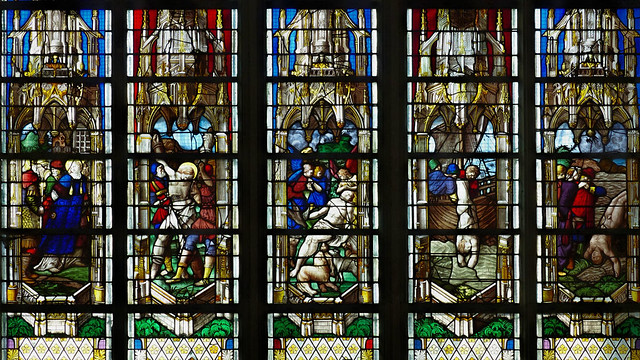The Life of St Vincent - Abbey Church of Saint-Ouen, Rouen

This window (c1550) illustrates episodes from the martyrdom of St Vincent of Saragossa, one of the most widely venerated deacons of the early Church. Created by a Rouen atelier in the early sixteenth century, the glass adopts the familiar layout of the Saint-Ouen narrative series: scenes arranged beneath richly architectural Gothic canopies, each panel presenting a distinct moment from the saint’s Passion.
At the left, Vincent appears before the Roman governor Dacian. The composition reflects the standard judicial setting of martyr cycles: Vincent, in deacon’s vestments, stands resolute while the governor, flanked by attendants or guards, delivers his judgement. The architectural surrounds, underscores the authority of the imperial court.
The subsequent panels depict Vincent’s torture. In one, the saint is stretched on a frame, his limbs bound as soldiers tighten ropes or apply pressure. The vibrant colours and sharply defined gestures heighten the sense of physical strain. A second scene intensifies this violence: Vincent’s body is further racked or he is beaten while a torturer wields an implement, the setting now outdoors, indicated by landscape elements behind the canopy.
At the centre of the window, Vincent is thrown into the sea, an episode derived from later versions of his Passion, in which his persecutors attempt to dispose of his body. Here he is shown tied and suspended over the gunwale while soldiers or sailors look on. The calm water and low horizon contrast with the brutality of the act.
To the far right, the narrative shows the miraculous preservation of Vincent’s body. According to tradition, his corpse, cast into the sea and guarded by chains or millstones, was watched over by seabirds until Christians recovered it. The panel reflects this episode: Vincent’s lifeless form lies on the shore while figures approach in reverence, the surrounding landscape signalling the transition from violence to veneration.
The lower registers, as in other windows of the series, provide spatial grounding with architectural bases and patterned borders, while the upper canopies, richly gilded and pierced with tracery, unify the cycle visually. Together, these scenes present a concise but powerful account of Vincent’s constancy under persecution and the miraculous signs that accompanied his martyrdom, themes that held strong devotional appeal throughout the later Middle Ages, particularly in monastic settings such as Saint-Ouen.
